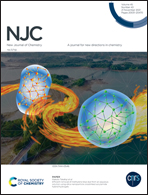A water-soluble fluorescent sensor for the quick discrimination of H2O and D2O by notable signal outputs and the real-time monitoring of food spoilage in a non-contact mode†
Abstract
Due to the very similar chemical and physical properties, D2O and H2O cannot be discriminated easily by convenient and cost-effective ways. Up to now, small organic molecules with active deprotonating ability in a very weak alkaline solution are proposed to deal with this fascinating yet challenging research. In this contribution, TPA-DP-COOH, a carboxylic acid group-substituted fluorescent substance, is demonstrated as a sensor to detect D2O and H2O with an external interference-free style, which not only displays a huge different signal output in D2O and H2O, but also very low limits of detection (LOD) as 49.08 ppm (D2O in H2O) and 0.23 ppm (H2O in D2O), respectively. Thus, these excellent sensing behaviors encourage us to fabricate TPA-DP-COOH and TPA-DP-COOK-absorbed filter papers as cost-effective and portable test strips, which are able to monitor the spoilage of Dimocarpus longan Lour and white leg shrimp in a non-contact mode during the storing process.



 Please wait while we load your content...
Please wait while we load your content...